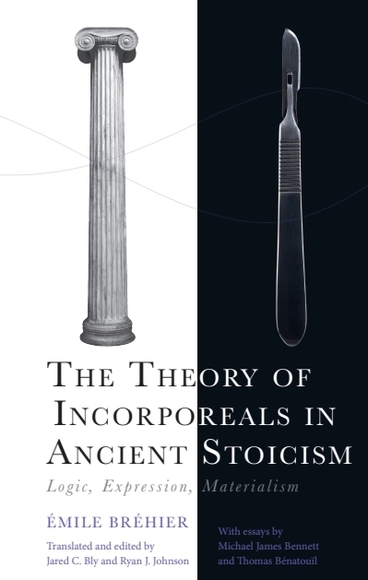
By Ryan J. Johnson and Jared C. Bly

Jared C. Bly and Ryan J. Johnson are the editors and translators of Émile Bréhier’s The Theory of Incorporeals in Ancient Stoicism, a classic essay from one of the twentieth-century’s leading historians of European philosophy.
Who is Émile Bréhier?
Like many young American grad students enamored with French Thought, we devoured the big names – Sartre, Foucault, Derrida, Deleuze. As we did, however, other names started appearing in the borders, background and references. The more they did, the more we glimpsed the (much) wider context of 20th-century French philosophy. There was a lot more to the story than we first assumed.
Among the big names, Gilles Deleuze was most intriguing to us, and Logique du sens his most intriguing text. After one read, we were hooked. After a second, unexpected things appeared. During a third, a name stood out – ‘Émile Bréhier.’
‘Bréhier’ appears most in the second chapter of Logic of Sense, the ‘Second Series of Paradoxes of Surface Effects,’ which begins with the Stoics and their ontological formulation of a tantalizing concept: the ‘incorporeal.’ After some fascinating – and confounding – elaborations of Stoic theory came that name: ‘In his fine reconstruction of Stoic thought, Émile Bréhier says…,’ followed by the largest block quote in the book.
For nearly half a page, Deleuze quotes Bréhier writing of scalpels slicing through flesh, an act that generates a new attribute – ‘being cut’ – which is expressed in a verb that separates two planes of being – bodily forces and an ‘endless multiplicity of incorporeal beings’ that ‘frolic on the surface of being.’
What did this mean, we thought? If this ‘Bréhier’ is so important, why has no one translated his text from which Deleuze quotes at such a pivotal moment in Logic of Sense?
Years later, Ryan was still asking those questions. After publishing The Deleuze-Lucretius Encounter in 2017, he kept thinking about Deleuze’s relationship to other ancient traditions. While his Lucretius book focused on Difference and Repetition, writing on the Stoics brought him back to Logic of Sense, especially that second chapter.
Soon, what became Deleuze, a Stoic emerged – and so did an idea. What if, Ryan thought, he translated Bréhier’s La Théorie des incorporels dans l’ancien stoïcisme and include it as an appendix to his Deleuze and Stoicism book, just as Deleuze appended essays to Logique du sens? Given Ryan’s limited translation skills, he would need help. So he contacted Jared, who was, as usual, totally game.
Blocked Paths
Jared and Ryan had become friends years earlier at a conference in North Texas. When Ryan reached out about the Bréhier text, Jared had been researching and translating French philosophy for a long time, focusing mostly on the various rationalist and epistemological threads informing Deleuze’s thought. By then an experienced translator, Jared was eager to bring voices like Bréhier’s into Anglophone philosophy.
Thus, in summer 2017, Ryan drafted a full translation of Bréhier’s La Théorie des incorporels and sent it to Jared, who worked his magic. In a few months, we had a complete, fairly polished version.
The next step was to contact J. Vrin, who owned the rights, and request copyright and permissions. To our dismay, they only allowed translations of exclusively Bréhier works.
Frustrated, we enlisted the help of the wonderful Carol Macdonald, Publisher for Philosophy at Edinburgh University Press, who did her best. Yet one-by-one, each path was blocked, and we soon admitted defeat. It was disappointing, especially as Ryan felt he had lured Jared into a project that now seemed destined to go nowhere.
That was in 2018.
And just like that, we’re back!
Two years later, the COVID-19 pandemic hit and locked us all inside. To cope, scholars formed reading groups or took them online and expanded membership. One group was the ‘Critical History of Medieval and Renaissance Philosophy Workshop,’ organized by the esteemed Andrew LaZella and Richard A. Lee, Jr.
At each meeting, attendees presented works in progress. Meetings were lively, therapeutic and productive. At one, Andrew shared a book project he was writing on Peter Abelard’s nominalism, which inspired Ryan to share relevant chapters from Deleuze, a Stoic. Andrew responded appreciatively and made an unexpected suggestion: ‘I noticed that you had translated large sections of Brehier’s book…I have long thought this would be a great book to translate and publish in our series [Cycles]. Is this something you might be interested in undertaking?’
And just like that, we were back!
Things got better when J.Vrin told us that, since Bréhier died in 1952, his works would enter the public domain in 2023. As long as it came out after then, we didn’t need copyright or permission.
Eventually, we organized a volume. With La Théorie des incorporels dans l’ancien stoïcisme as its centerpiece, we would include essays from scholarly experts on Bréhier, Hellenistic Philosophy, and contemporary French Thought. To our delight, Michael J. Bennett and Thomas Bénatouïl agreed, and in our volume you can read Michael’s beautiful Introduction and Thomas’ excellent reflection essay.
Like many works of philosophy, in translation or not, it all began on a whim and a chance encounter. Whatever the causes and wherever the paths, a strange idea under a Greek porch emerged long ago, sparkled in and out of conversation for 2,000 years, was crystalized into a material force in twentieth-century France and pulsates still in these very words.
Without noticing it, an incorporeal brought us all together – you, the Stoics, Bréhier, Deleuze, Ryan, Andrew, Jared, Thomas, Michael, Carol and more. As Deleuze and Guattari write at the beginning of A Thousand Plateaus, ‘Since each of us was several, there was already quite a crowd.’ It took a crowd, and at least one incorporeal, to make this book happen. Now y’all are a part of it.
About the authors
Jared C. Bly holds a PhD in Philosophy from Villanova University, having defended his dissertation in Spring of 2023. He currently works as an instructor in philosophy and humanities at Villanova University, and as an experienced translator of French. Jared’s research concerns social-political philosophy and critical theory as well as aesthetics (the philosophy of the image, photography and film theory). He is the translator of texts by Gilles Deleuze, Elie During and Patrick Vauday among others. Jared is currently spearheading the publication of an edited volume entitled Aesthetics After Althusser and finds himself in the beginning stages of preparing a book manuscript on ideology critique, aesthetics and anti-colonial revolution.
Ryan J. Johnson is Associate Professor and Chair of the Philosophy Department at Elon University, in North Carolina. Ryan’s early books include The Deleuze-Lucretius Encounter (Edinburgh UP 2016) and Deleuze, A Stoic (Edinburgh UP 2020), as well as the co-edited collections Contemporary Encounters with Ancient Metaphysics (Edinburgh UP 2018) and Nietzsche and Epicurus (Bloomsbury 2020). His recent work includes the co-written Phenomenology of Black Spirit (Edinburgh UP 2023), the co-edited collection Contemporary Encounters with Ancient Practice (Edinburgh UP 2024) and the monograph Three American Hegels (Rowman & Littlefield 2024). His future work is on the radical abolitionist John Brown, Spinoza, and John Coltrane.






